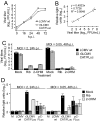Generation of recombinant lymphocytic choriomeningitis viruses with trisegmented genomes stably expressing two additional genes of interest
- PMID: 19208813
- PMCID: PMC2651270
- DOI: 10.1073/pnas.0900088106
Generation of recombinant lymphocytic choriomeningitis viruses with trisegmented genomes stably expressing two additional genes of interest
Abstract
Several arenaviruses cause hemorrhagic fever disease in humans for which no licensed vaccines are available and current therapeutic intervention is limited to the off-label use of the wide-spectrum antiviral ribavirin. However, the prototypic arenavirus lymphocytic choriomeningitis virus (LCMV) has proven to be a Rosetta stone for the investigation of virus-host interactions. Arenaviruses have a bisegmented negative-strand RNA genome. The S segment encodes for the virus nucleoprotein and glycoprotein, whereas the L segment encodes for the virus polymerase (L) and Z protein. The ability to generate recombinant LCMV (rLCMV) expressing additional foreign genes of interest would open novel avenues for the study of virus-host interactions and the development of novel vaccine strategies and high-throughput screens to identify antiarenaviral molecules. To this end, we have developed a trisegmented (1L + 2S) rLCMV-based approach (r3LCMV). Each of the two S segments in r3LCMV was altered to replace one of the viral genes by a gene of interest. All r3LCMVs examined expressing different reported genes were stable both genetically and phenotypically and exhibited wild-type growth properties in cultured cells. Reporter gene expression in r3LCMV-infected cells provided an accurate surrogate of levels of virus multiplication. Notably, some r3LCMVs displayed highly attenuated virulence in mice but induced protective immunity against a subsequent lethal challenge with wild-type LCMV, supporting the potential development of r3LCMV-based vaccines.
Conflict of interest statement
The authors declare no conflict of interest.
Figures








Similar articles
-
Arenavirus Genome Rearrangement for the Development of Live Attenuated Vaccines.J Virol. 2015 Jul;89(14):7373-84. doi: 10.1128/JVI.00307-15. Epub 2015 May 13. J Virol. 2015. PMID: 25972555 Free PMC article.
-
Development of live-attenuated arenavirus vaccines based on codon deoptimization.J Virol. 2015 Apr;89(7):3523-33. doi: 10.1128/JVI.03401-14. Epub 2015 Jan 14. J Virol. 2015. PMID: 25589652 Free PMC article.
-
Molecular Engineering of a Mammarenavirus with Unbreachable Attenuation.J Virol. 2023 Jan 31;97(1):e0138522. doi: 10.1128/jvi.01385-22. Epub 2022 Dec 19. J Virol. 2023. PMID: 36533953 Free PMC article.
-
Lymphocytic choriomeningitis virus: ways to establish and maintain non-cytolytic persistent infection.Acta Virol. 2016 Mar;60(1):15-26. doi: 10.4149/av_2016_01_15. Acta Virol. 2016. PMID: 26982463 Review.
-
Lymphocytic choriomeningitis virus: invisible but not innocent.Acta Virol. 2013;57(2):160-70. doi: 10.4149/av_2013_02_160. Acta Virol. 2013. PMID: 23600874 Review.
Cited by
-
Single nucleoprotein residue modulates arenavirus replication complex formation.mBio. 2015 Apr 28;6(3):e00524-15. doi: 10.1128/mBio.00524-15. mBio. 2015. PMID: 25922393 Free PMC article.
-
Reporter-Expressing, Replicating-Competent Recombinant Arenaviruses.Viruses. 2016 Jul 20;8(7):197. doi: 10.3390/v8070197. Viruses. 2016. PMID: 27447662 Free PMC article. Review.
-
Development of a Recombinant Pichinde Virus-Vectored Vaccine against Turkey Arthritis Reovirus and Its Immunological Response Characterization in Vaccinated Animals.Pathogens. 2021 Feb 13;10(2):197. doi: 10.3390/pathogens10020197. Pathogens. 2021. PMID: 33668435 Free PMC article.
-
Lessons learned and concepts formed from study of the pathogenesis of the two negative-strand viruses lymphocytic choriomeningitis and influenza.Proc Natl Acad Sci U S A. 2013 Mar 12;110(11):4180-3. doi: 10.1073/pnas.1222025110. Epub 2013 Jan 22. Proc Natl Acad Sci U S A. 2013. PMID: 23341590 Free PMC article. Review.
-
Lupus acceleration by a MAVS-activating RNA virus requires endosomal TLR signaling and host genetic predisposition.PLoS One. 2018 Sep 10;13(9):e0203118. doi: 10.1371/journal.pone.0203118. eCollection 2018. PLoS One. 2018. PMID: 30199535 Free PMC article.
References
-
- Zinkernagel RM. Lymphocytic choriomeningitis virus and immunology. Curr Top Microbiol Immunol. 2002;263:1–5. - PubMed
-
- Günther S, Lenz O. Lassa virus. Crit Rev Clin Lab Sci. 2004;41:339–390. - PubMed
-
- Charrel RN, de Lamballerie X. Arenaviruses other than Lassa virus. Antiviral Res. 2003;57:89–100. - PubMed
-
- Barton LL. Lymphocytic choriomeningitis virus: A neglected central nervous system pathogen. Clin Infect Dis. 1996;22:197. - PubMed
-
- Fischer SA, et al. Transmission of lymphocytic choriomeningitis virus by organ transplantation. N Engl J Med. 2006;354:2235–2249. - PubMed
Publication types
MeSH terms
Grants and funding
LinkOut - more resources
Full Text Sources
Other Literature Sources

